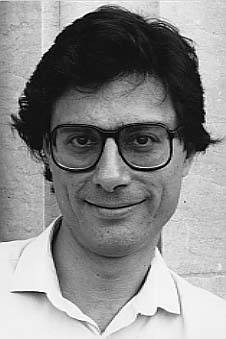

|

Richard Lavenda's music has been played by orchestras, choruses, chamber
ensembles, and soloists throughout the United States, Europe, and
Australia. These include the Houston Symphony Orchestra, the Slovak Radio
Orchestra, Da Camera, the Fischer Duo, the Pierrot Plus Ensemble, Earplay,
the Sun String Quartet, Duo Synergy/Prague, the Cluster Ensemble, and
Bricolage. He has been featured as a guest composer on many campuses and
concert series, and at festivals in Prague, Adelaide, Stuttgart, Lviv,
Ljubjana, and Turku, Finland. Lavenda's opera, "Barricade," which was
staged by the Shepherd School in 1995, recently won a major award from the
National Opera Association. His music is published by Norruth Music, Inc.
A native of New Jersey, Lavenda received his education at Dartmouth College, Rice University, and The University of Michigan, where he completed a doctorate in 1983. He is currently Associate Professor of Music at the Shepherd School of Music, Rice University. In addition to composition, he teaches courses in undergraduate theory, graduate analysis, aesthetics, pedagogy of theory, and a Practicum in Contemporary Music, where composers and performers collaborate on the creation of new works.

Quintet For Clarinet and String Quartet was commissioned by my friend, Richard Nunemaker, a superb clarinetist whose dedication to new music is legendary. He asked me for a big piece, one that might fill half of a program. "Think Brahms Quintet," he suggested. That challenge and inspiration was on my mind as I composed, and while the resulting piece is not as long as the Brahms, it is nonetheless a substantial workout for all involved.
I composed the Quintet in the summer and fall of 1997. Each of the three movements has its own character and identity, but each also shares certain harmonies and gestures with the others. One of these common traits is that the clarinet, while certainly prominent, is by no means always the soloist. Indeed, all the parts share equally in the presentation and development of the music, and the clarinet is at various times a member of the ensemble or an accompanist, as well as the soloist.
The first movement, "Blaze," is almost entirely intense and driving. There are attempts to add a lighter, more relaxed tone, but the initial energy always returns, ever stronger and more powerful. In contrast, the second movement, "Serenade," is gentle and unhurried, with melodies that are shared among the group of performers. The third movement, "Dynamo," is in three large sections. The first is primarily an accompanied cadenza for the clarinet, followed by a more lyrical though no less forceful section and ending with a return to the beginning of the movement. This time though, each instrument participates in the counterpoint, which includes canons and imitations of various kinds, unison passages which fan out into held chords, and intricate cross-rhythms all taking place in a rather brisk tempo!
Richard Lavenda